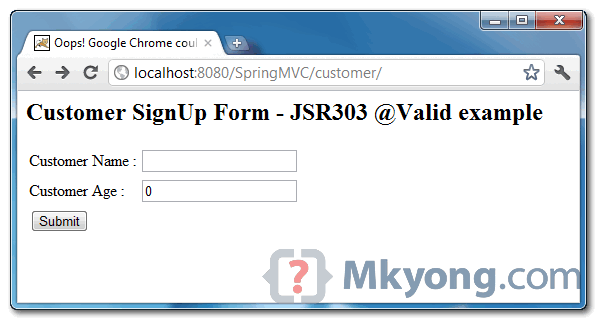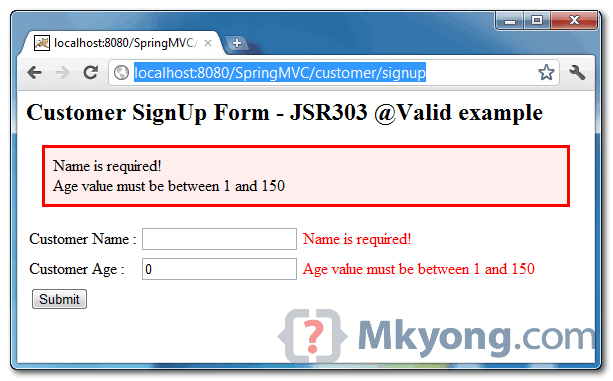In Spring 3, you can enable “mvc:annotation-driven” to support JSR303 bean validation via @Valid annotation, if any JSR 303 validator framework on the classpath.
Note
Hibernate Validator is the reference implementation for JSR 303
In this tutorial, we show you how to integrate Hibernate validator with Spring MVC, via@Validannotation, to perform bean validation in a HTML form.
Technologies used :
- Spring 3.0.5.RELEASE
- Hibernate Validator 4.2.0.Final
- JDK 1.6
- Eclipse 3.6
- Maven 3
1. Project Dependencies
Hibernate validator is available at JBoss public repository.
<repositories>
<repository>
<id>JBoss repository</id>
<url>http://repository.jboss.org/nexus/content/groups/public/</url>
</repository>
</repositories>
<properties>
<spring.version>3.0.5.RELEASE</spring.version>
</properties>
<dependencies>
<!-- Spring 3 dependencies -->
<dependency>
<groupId>org.springframework</groupId>
<artifactId>spring-core</artifactId>
<version>${spring.version}</version>
</dependency>
<dependency>
<groupId>org.springframework</groupId>
<artifactId>spring-web</artifactId>
<version>${spring.version}</version>
</dependency>
<dependency>
<groupId>org.springframework</groupId>
<artifactId>spring-webmvc</artifactId>
<version>${spring.version}</version>
</dependency>
<!-- Hibernate Validator -->
<dependency>
<groupId>org.hibernate</groupId>
<artifactId>hibernate-validator</artifactId>
<version>4.2.0.Final</version>
</dependency>
</dependencies>2. JSR303 Bean Validation
A simple POJO, annotated with Hibernate validator annotation.
package com.mkyong.common.model;
import org.hibernate.validator.constraints.NotEmpty;
import org.hibernate.validator.constraints.Range;
public class Customer {
@NotEmpty //make sure name is not empty
String name;
@Range(min = 1, max = 150) //age need between 1 and 150
int age;
//getter and setter methods
}3. Controller + @Valid
For validation to work, just annotate the “JSR annotated model object” via @Valid. That’s all, other stuff is just a normal Spring MVC form handling.
package com.mkyong.common.controller;
import javax.validation.Valid;
import org.springframework.stereotype.Controller;
import org.springframework.ui.ModelMap;
import org.springframework.validation.BindingResult;
import org.springframework.web.bind.annotation.RequestMapping;
import org.springframework.web.bind.annotation.RequestMethod;
import com.mkyong.common.model.Customer;
@Controller
@RequestMapping("/customer")
public class SignUpController {
@RequestMapping(value = "/signup", method = RequestMethod.POST)
public String addCustomer(@Valid Customer customer, BindingResult result) {
if (result.hasErrors()) {
return "SignUpForm";
} else {
return "Done";
}
}
@RequestMapping(method = RequestMethod.GET)
public String displayCustomerForm(ModelMap model) {
model.addAttribute("customer", new Customer());
return "SignUpForm";
}
}4. Error Message
By default, if validation failed.
@NotEmpty will display “may not be empty”
@Range will display “must be between 1 and 150″
You can override it easily, create a properties with “key” and message. To know which @annotation bind to which key, just debug it and view value inside “BindingResult result“. Normally, the key is “@Annotation Name.object.fieldname“.
File : messages.properties
NotEmpty.customer.name = Name is required!
Range.customer.age = Age value must be between 1 and 1505. mvc:annotation-driven
Enable “mvc:annotation-driven” to make Spring MVC supports JSR303 validator via @Valid, and also bind your properties file.
<beans xmlns="http://www.springframework.org/schema/beans"
xmlns:context="http://www.springframework.org/schema/context"
xmlns:mvc="http://www.springframework.org/schema/mvc"
xmlns:xsi="http://www.w3.org/2001/XMLSchema-instance"
xsi:schemaLocation="
http://www.springframework.org/schema/beans
http://www.springframework.org/schema/beans/spring-beans-3.0.xsd
http://www.springframework.org/schema/context
http://www.springframework.org/schema/context/spring-context-3.0.xsd
http://www.springframework.org/schema/mvc
http://www.springframework.org/schema/mvc/spring-mvc-3.0.xsd">
<context:component-scan base-package="com.mkyong.common.controller" />
<!-- support JSR303 annotation if JSR 303 validation present on classpath -->
<mvc:annotation-driven />
<bean id="viewResolver"
class="org.springframework.web.servlet.view.InternalResourceViewResolver">
<property name="prefix">
<value>/WEB-INF/pages/</value>
</property>
<property name="suffix">
<value>.jsp</value>
</property>
</bean>
<!-- bind your messages.properties -->
<bean class="org.springframework.context.support.ResourceBundleMessageSource"
id="messageSource">
<property name="basename" value="messages" />
</bean>
</beans>6. JSP Pages
Last one, normal JSP page with Spring form tag library.
File : SignUpForm.jsp
<%@ taglib prefix="form" uri="http://www.springframework.org/tags/form"%>
<html>
<head>
<style>
.error {
color: #ff0000;
}
.errorblock {
color: #000;
background-color: #ffEEEE;
border: 3px solid #ff0000;
padding: 8px;
margin: 16px;
}
</style>
</head>
<body>
<h2>Customer SignUp Form - JSR303 @Valid example</h2>
<form:form method="POST" commandName="customer" action="customer/signup">
<form:errors path="*" cssClass="errorblock" element="div" />
<table>
<tr>
<td>Customer Name :</td>
<td><form:input path="name" /></td>
<td><form:errors path="name" cssClass="error" /></td>
</tr>
<tr>
<td>Customer Age :</td>
<td><form:input path="age" /></td>
<td><form:errors path="age" cssClass="error" /></td>
</tr>
<tr>
<td colspan="3"><input type="submit" /></td>
</tr>
</table>
</form:form>
</body>
</html>File : Done.jsp
<html>
<body>
<h2>Done</h2>
</body>
</html>6. Demo
URL : http://localhost:8080/SpringMVC/customer – Customer form page, with 2 text boxes for name and age.

URL : http://localhost:8080/SpringMVC/customer/signup – If you didn’t fill in the form and click on the “submit” button, your customized validation error messages will be displayed.























 139
139

 被折叠的 条评论
为什么被折叠?
被折叠的 条评论
为什么被折叠?








